International Business: Ethical Textile Manufacturing Report
VerifiedAdded on 2022/12/12
|9
|1597
|76
Report
AI Summary
This report provides an analysis of the challenges and opportunities faced by an Australian clothing chain seeking an international textile manufacturer. It focuses on ethical clothing concerns, including social and environmental impacts in countries like India, Bangladesh, China, and Vietnam. The report emphasizes the importance of ethical sourcing, sustainable manufacturing, and reducing pollution. It outlines the rationale for conducting additional research on potential suppliers, highlighting the risks associated with neglecting these factors. A research plan is presented, focusing on waste reduction, the substitution of toxic chemicals, and adherence to environmental regulations. The conclusion stresses the importance of government support for sustainable practices and the need for educational programs to promote ethical and eco-friendly concepts within the textile industry. The report also mentions the risks associated with hazardous materials and the importance of environmental protection.
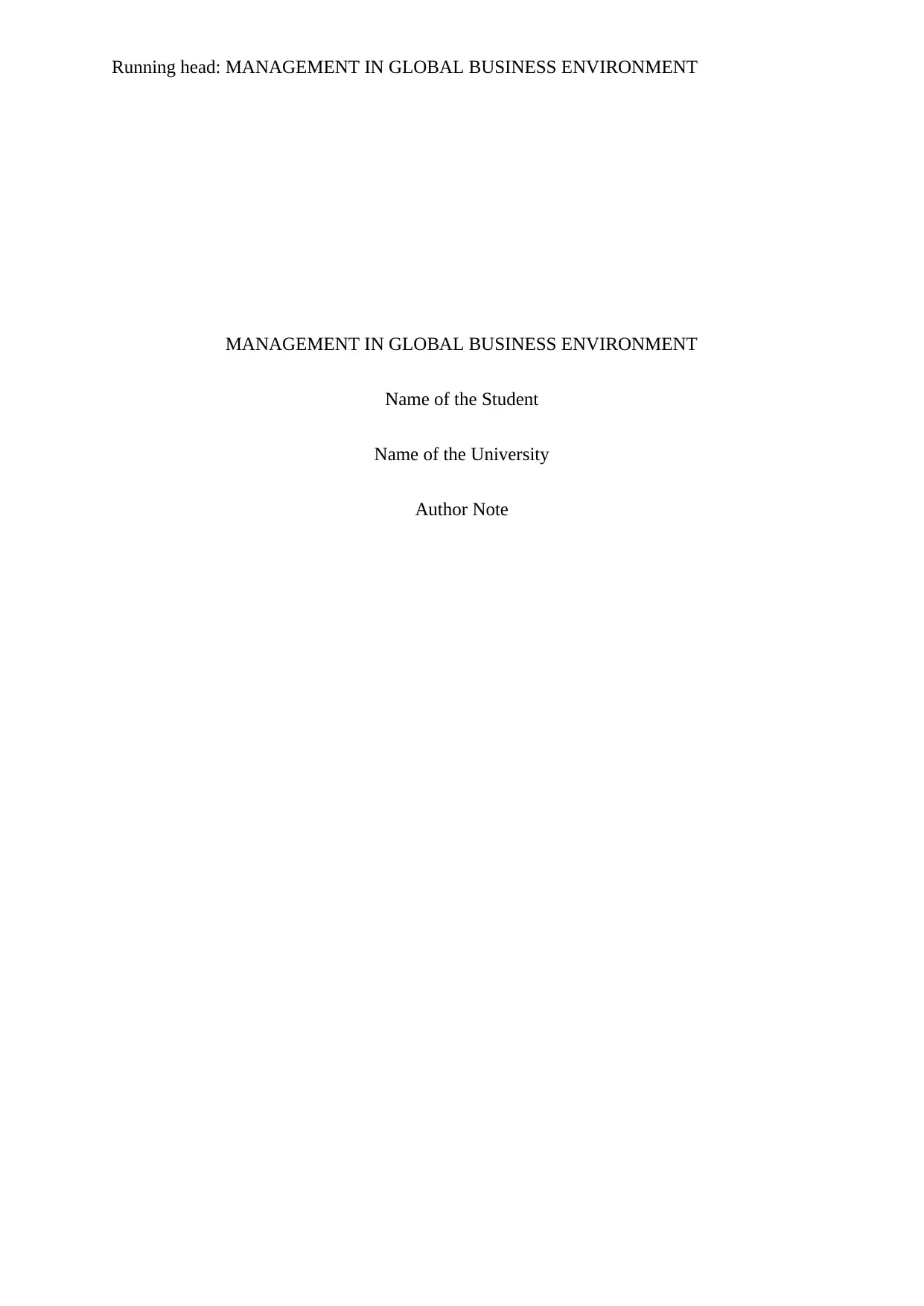
Running head: MANAGEMENT IN GLOBAL BUSINESS ENVIRONMENT
MANAGEMENT IN GLOBAL BUSINESS ENVIRONMENT
Name of the Student
Name of the University
Author Note
MANAGEMENT IN GLOBAL BUSINESS ENVIRONMENT
Name of the Student
Name of the University
Author Note
Paraphrase This Document
Need a fresh take? Get an instant paraphrase of this document with our AI Paraphraser
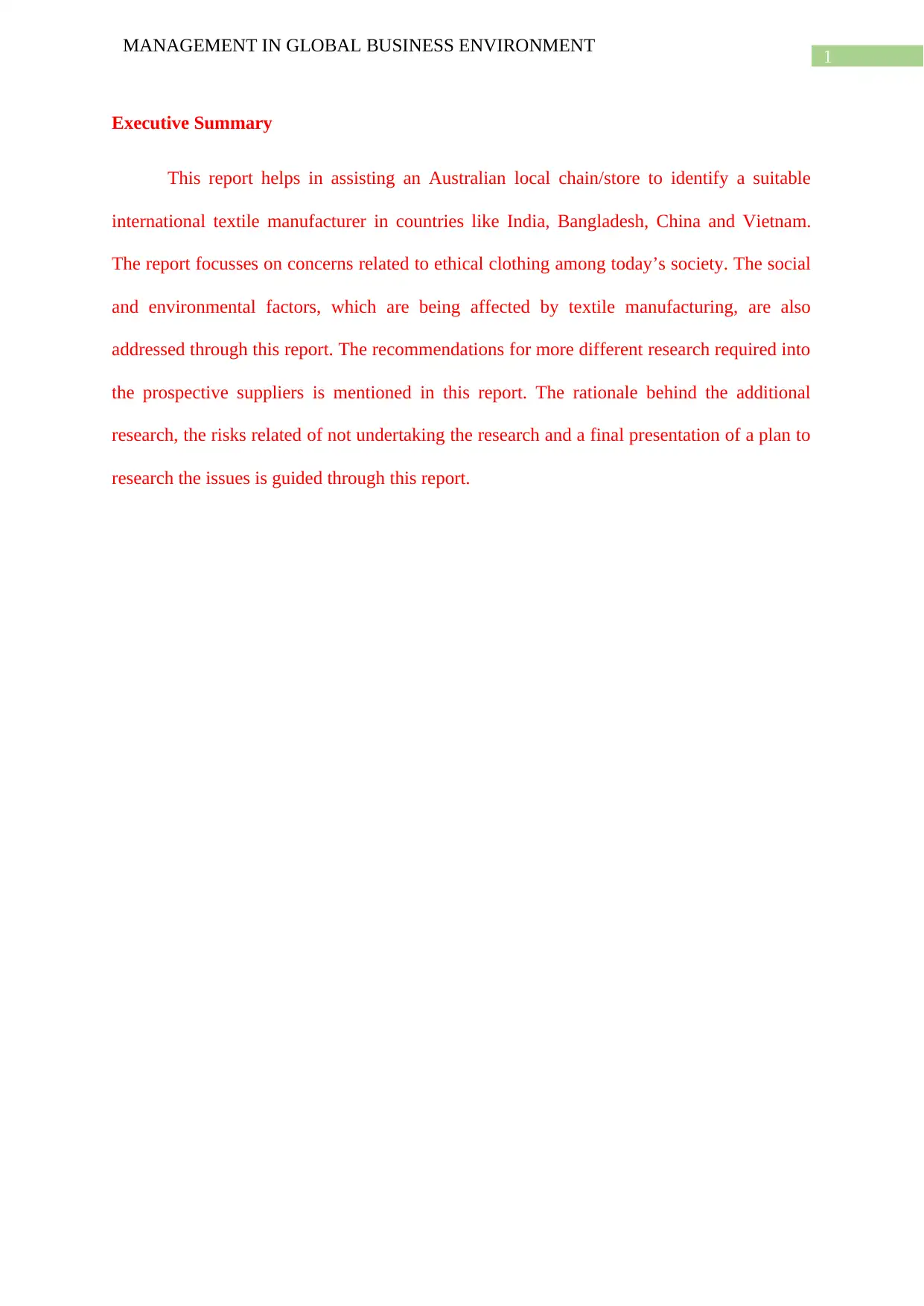
1
MANAGEMENT IN GLOBAL BUSINESS ENVIRONMENT
Executive Summary
This report helps in assisting an Australian local chain/store to identify a suitable
international textile manufacturer in countries like India, Bangladesh, China and Vietnam.
The report focusses on concerns related to ethical clothing among today’s society. The social
and environmental factors, which are being affected by textile manufacturing, are also
addressed through this report. The recommendations for more different research required into
the prospective suppliers is mentioned in this report. The rationale behind the additional
research, the risks related of not undertaking the research and a final presentation of a plan to
research the issues is guided through this report.
MANAGEMENT IN GLOBAL BUSINESS ENVIRONMENT
Executive Summary
This report helps in assisting an Australian local chain/store to identify a suitable
international textile manufacturer in countries like India, Bangladesh, China and Vietnam.
The report focusses on concerns related to ethical clothing among today’s society. The social
and environmental factors, which are being affected by textile manufacturing, are also
addressed through this report. The recommendations for more different research required into
the prospective suppliers is mentioned in this report. The rationale behind the additional
research, the risks related of not undertaking the research and a final presentation of a plan to
research the issues is guided through this report.
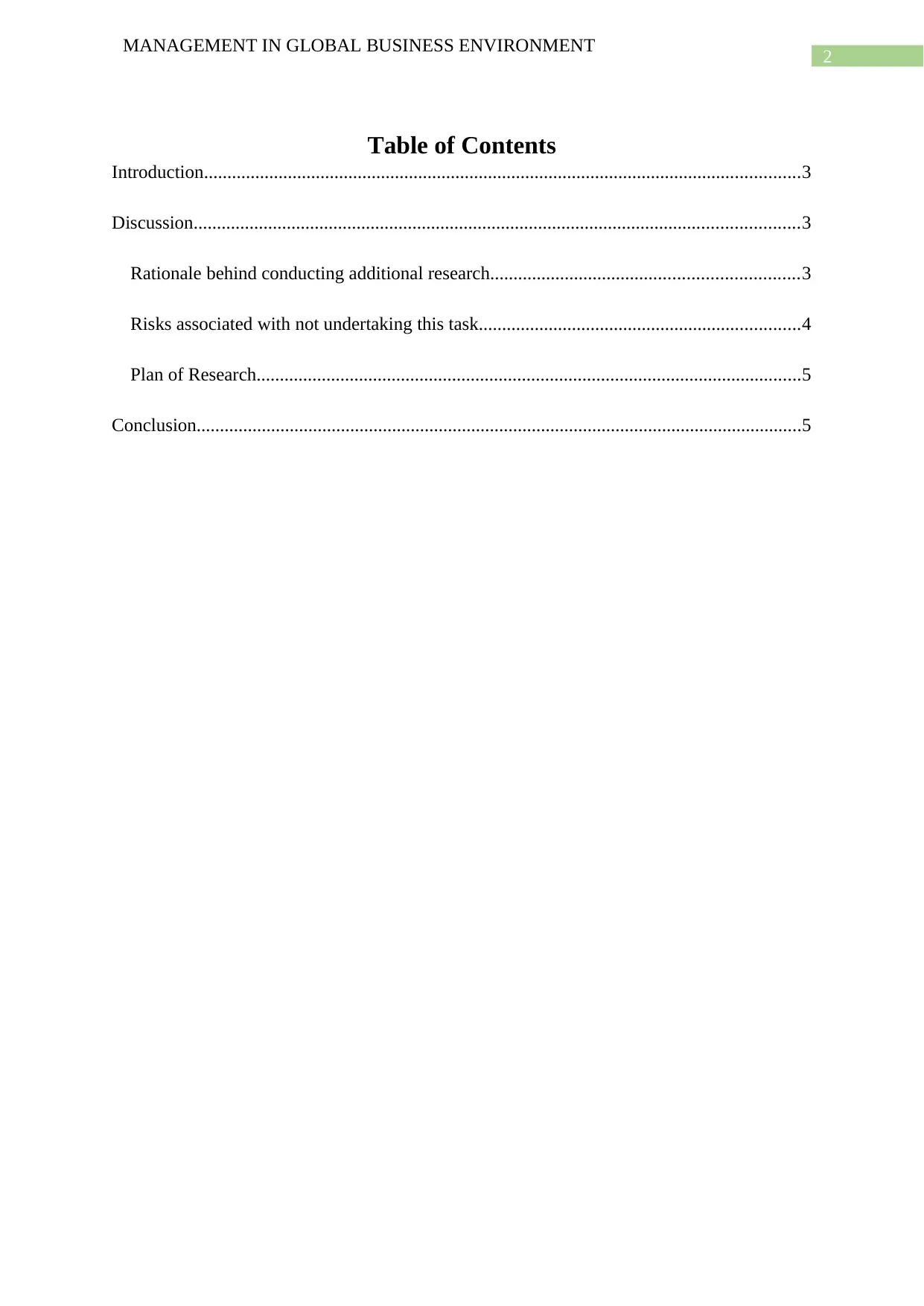
2
MANAGEMENT IN GLOBAL BUSINESS ENVIRONMENT
Table of Contents
Introduction................................................................................................................................3
Discussion..................................................................................................................................3
Rationale behind conducting additional research..................................................................3
Risks associated with not undertaking this task.....................................................................4
Plan of Research.....................................................................................................................5
Conclusion..................................................................................................................................5
MANAGEMENT IN GLOBAL BUSINESS ENVIRONMENT
Table of Contents
Introduction................................................................................................................................3
Discussion..................................................................................................................................3
Rationale behind conducting additional research..................................................................3
Risks associated with not undertaking this task.....................................................................4
Plan of Research.....................................................................................................................5
Conclusion..................................................................................................................................5
⊘ This is a preview!⊘
Do you want full access?
Subscribe today to unlock all pages.

Trusted by 1+ million students worldwide
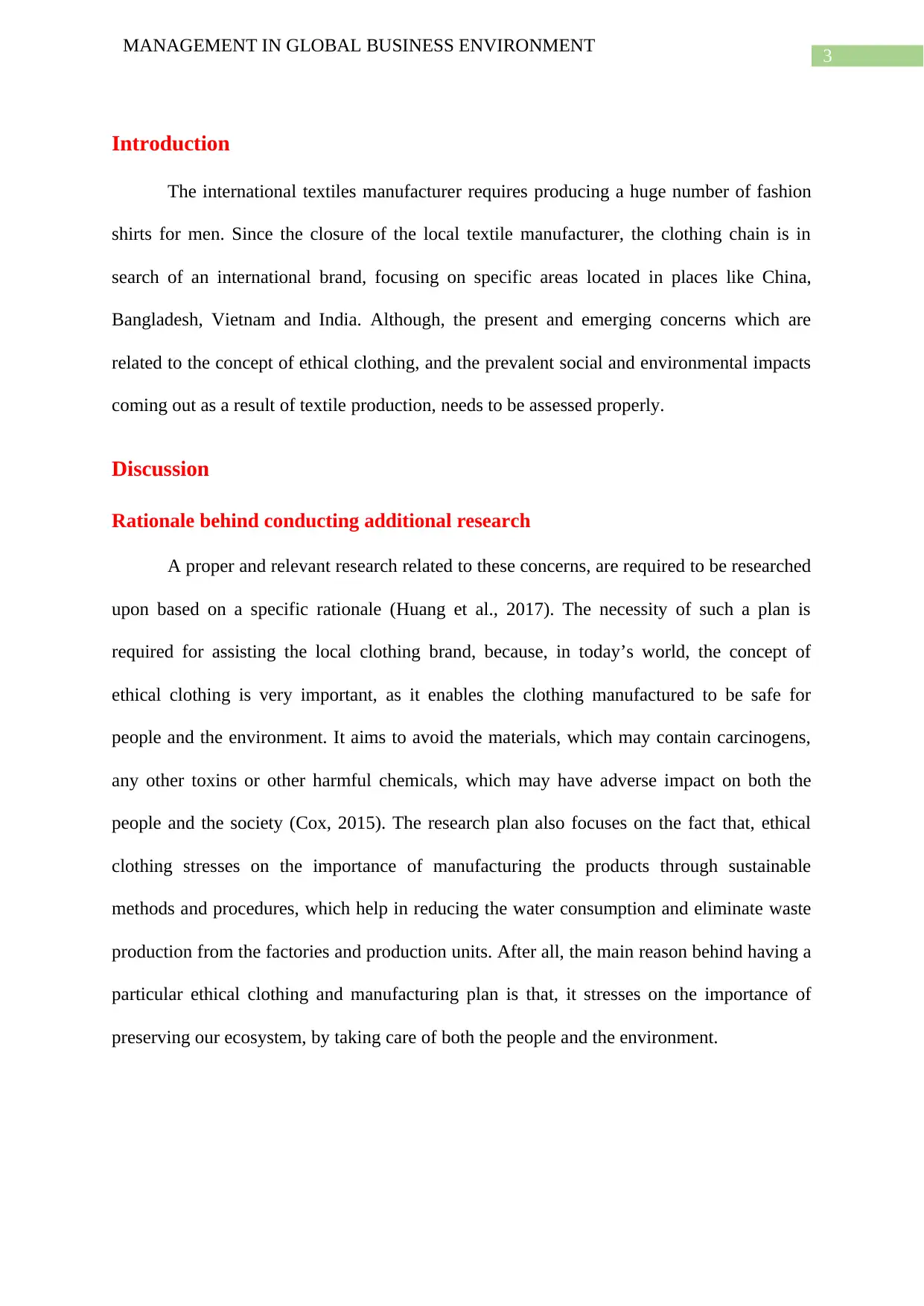
3
MANAGEMENT IN GLOBAL BUSINESS ENVIRONMENT
Introduction
The international textiles manufacturer requires producing a huge number of fashion
shirts for men. Since the closure of the local textile manufacturer, the clothing chain is in
search of an international brand, focusing on specific areas located in places like China,
Bangladesh, Vietnam and India. Although, the present and emerging concerns which are
related to the concept of ethical clothing, and the prevalent social and environmental impacts
coming out as a result of textile production, needs to be assessed properly.
Discussion
Rationale behind conducting additional research
A proper and relevant research related to these concerns, are required to be researched
upon based on a specific rationale (Huang et al., 2017). The necessity of such a plan is
required for assisting the local clothing brand, because, in today’s world, the concept of
ethical clothing is very important, as it enables the clothing manufactured to be safe for
people and the environment. It aims to avoid the materials, which may contain carcinogens,
any other toxins or other harmful chemicals, which may have adverse impact on both the
people and the society (Cox, 2015). The research plan also focuses on the fact that, ethical
clothing stresses on the importance of manufacturing the products through sustainable
methods and procedures, which help in reducing the water consumption and eliminate waste
production from the factories and production units. After all, the main reason behind having a
particular ethical clothing and manufacturing plan is that, it stresses on the importance of
preserving our ecosystem, by taking care of both the people and the environment.
MANAGEMENT IN GLOBAL BUSINESS ENVIRONMENT
Introduction
The international textiles manufacturer requires producing a huge number of fashion
shirts for men. Since the closure of the local textile manufacturer, the clothing chain is in
search of an international brand, focusing on specific areas located in places like China,
Bangladesh, Vietnam and India. Although, the present and emerging concerns which are
related to the concept of ethical clothing, and the prevalent social and environmental impacts
coming out as a result of textile production, needs to be assessed properly.
Discussion
Rationale behind conducting additional research
A proper and relevant research related to these concerns, are required to be researched
upon based on a specific rationale (Huang et al., 2017). The necessity of such a plan is
required for assisting the local clothing brand, because, in today’s world, the concept of
ethical clothing is very important, as it enables the clothing manufactured to be safe for
people and the environment. It aims to avoid the materials, which may contain carcinogens,
any other toxins or other harmful chemicals, which may have adverse impact on both the
people and the society (Cox, 2015). The research plan also focuses on the fact that, ethical
clothing stresses on the importance of manufacturing the products through sustainable
methods and procedures, which help in reducing the water consumption and eliminate waste
production from the factories and production units. After all, the main reason behind having a
particular ethical clothing and manufacturing plan is that, it stresses on the importance of
preserving our ecosystem, by taking care of both the people and the environment.
Paraphrase This Document
Need a fresh take? Get an instant paraphrase of this document with our AI Paraphraser
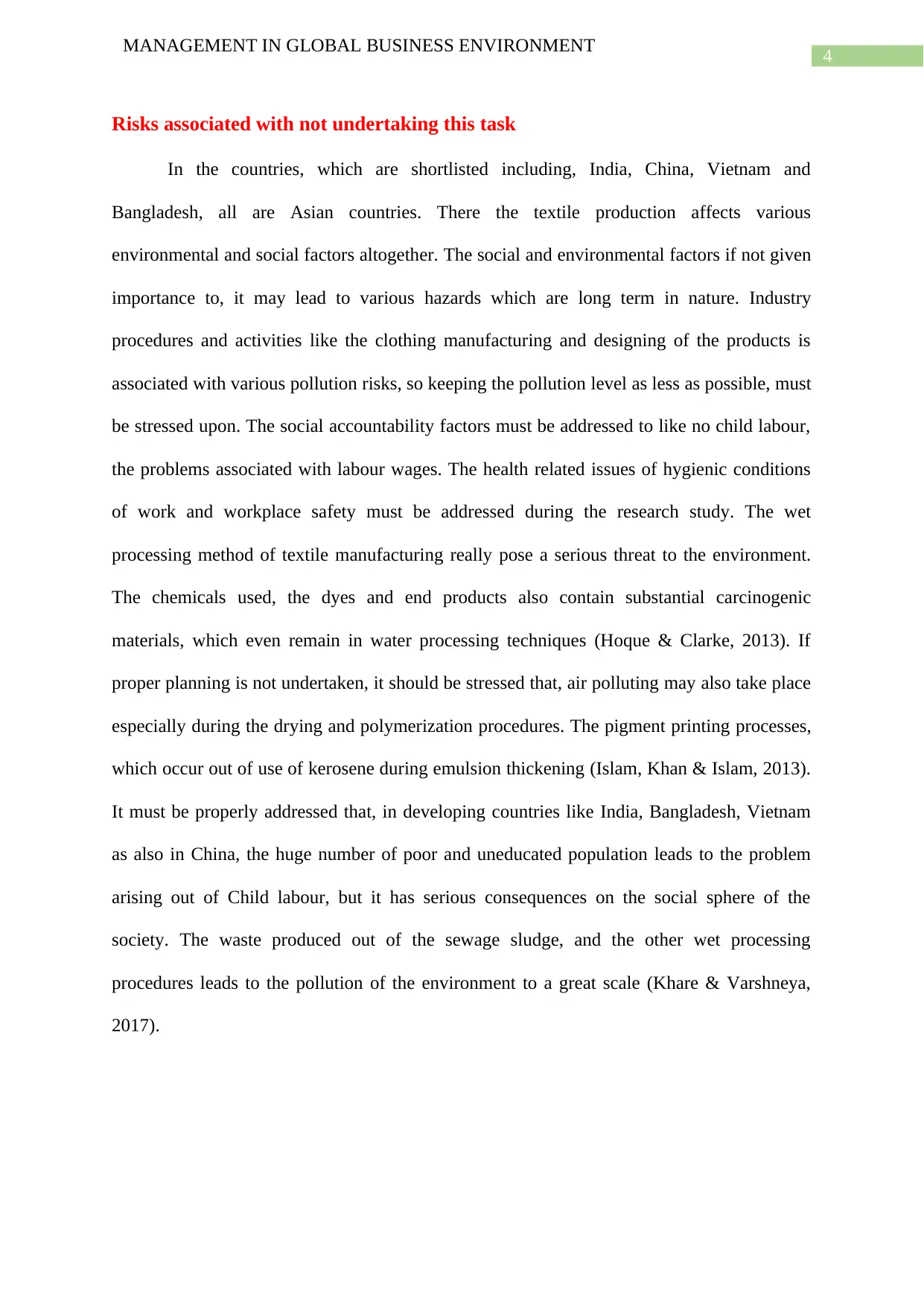
4
MANAGEMENT IN GLOBAL BUSINESS ENVIRONMENT
Risks associated with not undertaking this task
In the countries, which are shortlisted including, India, China, Vietnam and
Bangladesh, all are Asian countries. There the textile production affects various
environmental and social factors altogether. The social and environmental factors if not given
importance to, it may lead to various hazards which are long term in nature. Industry
procedures and activities like the clothing manufacturing and designing of the products is
associated with various pollution risks, so keeping the pollution level as less as possible, must
be stressed upon. The social accountability factors must be addressed to like no child labour,
the problems associated with labour wages. The health related issues of hygienic conditions
of work and workplace safety must be addressed during the research study. The wet
processing method of textile manufacturing really pose a serious threat to the environment.
The chemicals used, the dyes and end products also contain substantial carcinogenic
materials, which even remain in water processing techniques (Hoque & Clarke, 2013). If
proper planning is not undertaken, it should be stressed that, air polluting may also take place
especially during the drying and polymerization procedures. The pigment printing processes,
which occur out of use of kerosene during emulsion thickening (Islam, Khan & Islam, 2013).
It must be properly addressed that, in developing countries like India, Bangladesh, Vietnam
as also in China, the huge number of poor and uneducated population leads to the problem
arising out of Child labour, but it has serious consequences on the social sphere of the
society. The waste produced out of the sewage sludge, and the other wet processing
procedures leads to the pollution of the environment to a great scale (Khare & Varshneya,
2017).
MANAGEMENT IN GLOBAL BUSINESS ENVIRONMENT
Risks associated with not undertaking this task
In the countries, which are shortlisted including, India, China, Vietnam and
Bangladesh, all are Asian countries. There the textile production affects various
environmental and social factors altogether. The social and environmental factors if not given
importance to, it may lead to various hazards which are long term in nature. Industry
procedures and activities like the clothing manufacturing and designing of the products is
associated with various pollution risks, so keeping the pollution level as less as possible, must
be stressed upon. The social accountability factors must be addressed to like no child labour,
the problems associated with labour wages. The health related issues of hygienic conditions
of work and workplace safety must be addressed during the research study. The wet
processing method of textile manufacturing really pose a serious threat to the environment.
The chemicals used, the dyes and end products also contain substantial carcinogenic
materials, which even remain in water processing techniques (Hoque & Clarke, 2013). If
proper planning is not undertaken, it should be stressed that, air polluting may also take place
especially during the drying and polymerization procedures. The pigment printing processes,
which occur out of use of kerosene during emulsion thickening (Islam, Khan & Islam, 2013).
It must be properly addressed that, in developing countries like India, Bangladesh, Vietnam
as also in China, the huge number of poor and uneducated population leads to the problem
arising out of Child labour, but it has serious consequences on the social sphere of the
society. The waste produced out of the sewage sludge, and the other wet processing
procedures leads to the pollution of the environment to a great scale (Khare & Varshneya,
2017).
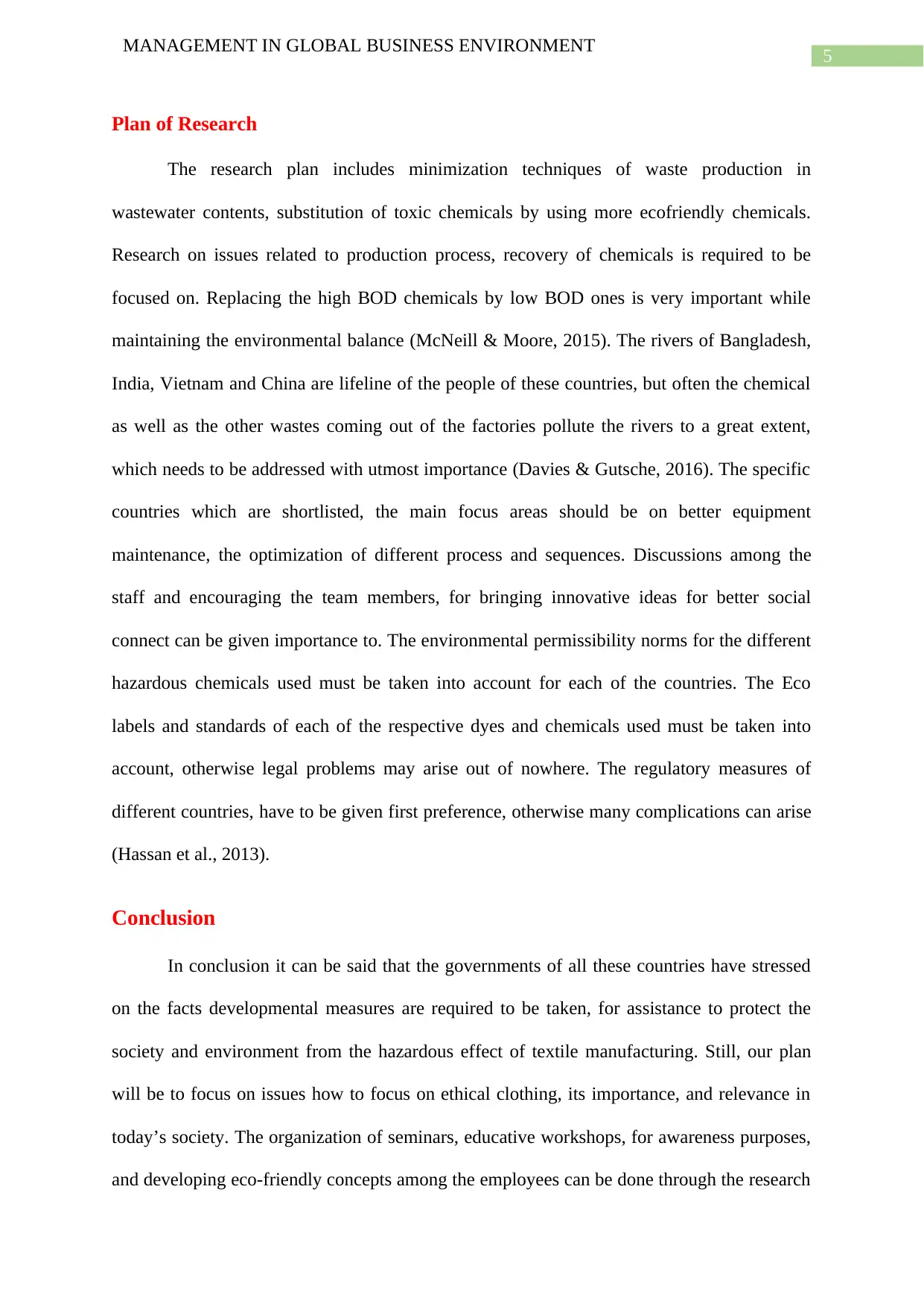
5
MANAGEMENT IN GLOBAL BUSINESS ENVIRONMENT
Plan of Research
The research plan includes minimization techniques of waste production in
wastewater contents, substitution of toxic chemicals by using more ecofriendly chemicals.
Research on issues related to production process, recovery of chemicals is required to be
focused on. Replacing the high BOD chemicals by low BOD ones is very important while
maintaining the environmental balance (McNeill & Moore, 2015). The rivers of Bangladesh,
India, Vietnam and China are lifeline of the people of these countries, but often the chemical
as well as the other wastes coming out of the factories pollute the rivers to a great extent,
which needs to be addressed with utmost importance (Davies & Gutsche, 2016). The specific
countries which are shortlisted, the main focus areas should be on better equipment
maintenance, the optimization of different process and sequences. Discussions among the
staff and encouraging the team members, for bringing innovative ideas for better social
connect can be given importance to. The environmental permissibility norms for the different
hazardous chemicals used must be taken into account for each of the countries. The Eco
labels and standards of each of the respective dyes and chemicals used must be taken into
account, otherwise legal problems may arise out of nowhere. The regulatory measures of
different countries, have to be given first preference, otherwise many complications can arise
(Hassan et al., 2013).
Conclusion
In conclusion it can be said that the governments of all these countries have stressed
on the facts developmental measures are required to be taken, for assistance to protect the
society and environment from the hazardous effect of textile manufacturing. Still, our plan
will be to focus on issues how to focus on ethical clothing, its importance, and relevance in
today’s society. The organization of seminars, educative workshops, for awareness purposes,
and developing eco-friendly concepts among the employees can be done through the research
MANAGEMENT IN GLOBAL BUSINESS ENVIRONMENT
Plan of Research
The research plan includes minimization techniques of waste production in
wastewater contents, substitution of toxic chemicals by using more ecofriendly chemicals.
Research on issues related to production process, recovery of chemicals is required to be
focused on. Replacing the high BOD chemicals by low BOD ones is very important while
maintaining the environmental balance (McNeill & Moore, 2015). The rivers of Bangladesh,
India, Vietnam and China are lifeline of the people of these countries, but often the chemical
as well as the other wastes coming out of the factories pollute the rivers to a great extent,
which needs to be addressed with utmost importance (Davies & Gutsche, 2016). The specific
countries which are shortlisted, the main focus areas should be on better equipment
maintenance, the optimization of different process and sequences. Discussions among the
staff and encouraging the team members, for bringing innovative ideas for better social
connect can be given importance to. The environmental permissibility norms for the different
hazardous chemicals used must be taken into account for each of the countries. The Eco
labels and standards of each of the respective dyes and chemicals used must be taken into
account, otherwise legal problems may arise out of nowhere. The regulatory measures of
different countries, have to be given first preference, otherwise many complications can arise
(Hassan et al., 2013).
Conclusion
In conclusion it can be said that the governments of all these countries have stressed
on the facts developmental measures are required to be taken, for assistance to protect the
society and environment from the hazardous effect of textile manufacturing. Still, our plan
will be to focus on issues how to focus on ethical clothing, its importance, and relevance in
today’s society. The organization of seminars, educative workshops, for awareness purposes,
and developing eco-friendly concepts among the employees can be done through the research
⊘ This is a preview!⊘
Do you want full access?
Subscribe today to unlock all pages.

Trusted by 1+ million students worldwide
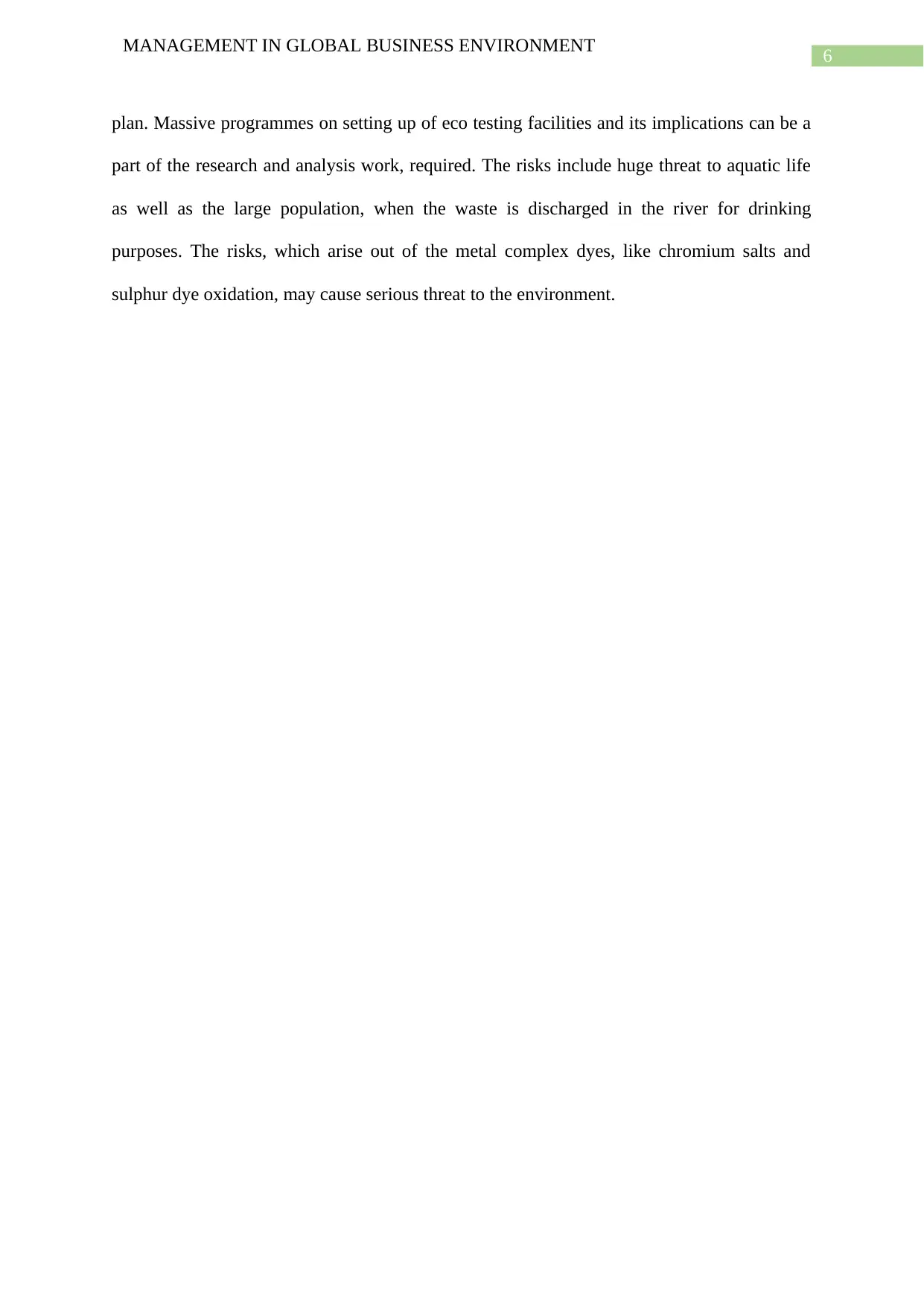
6
MANAGEMENT IN GLOBAL BUSINESS ENVIRONMENT
plan. Massive programmes on setting up of eco testing facilities and its implications can be a
part of the research and analysis work, required. The risks include huge threat to aquatic life
as well as the large population, when the waste is discharged in the river for drinking
purposes. The risks, which arise out of the metal complex dyes, like chromium salts and
sulphur dye oxidation, may cause serious threat to the environment.
MANAGEMENT IN GLOBAL BUSINESS ENVIRONMENT
plan. Massive programmes on setting up of eco testing facilities and its implications can be a
part of the research and analysis work, required. The risks include huge threat to aquatic life
as well as the large population, when the waste is discharged in the river for drinking
purposes. The risks, which arise out of the metal complex dyes, like chromium salts and
sulphur dye oxidation, may cause serious threat to the environment.
Paraphrase This Document
Need a fresh take? Get an instant paraphrase of this document with our AI Paraphraser
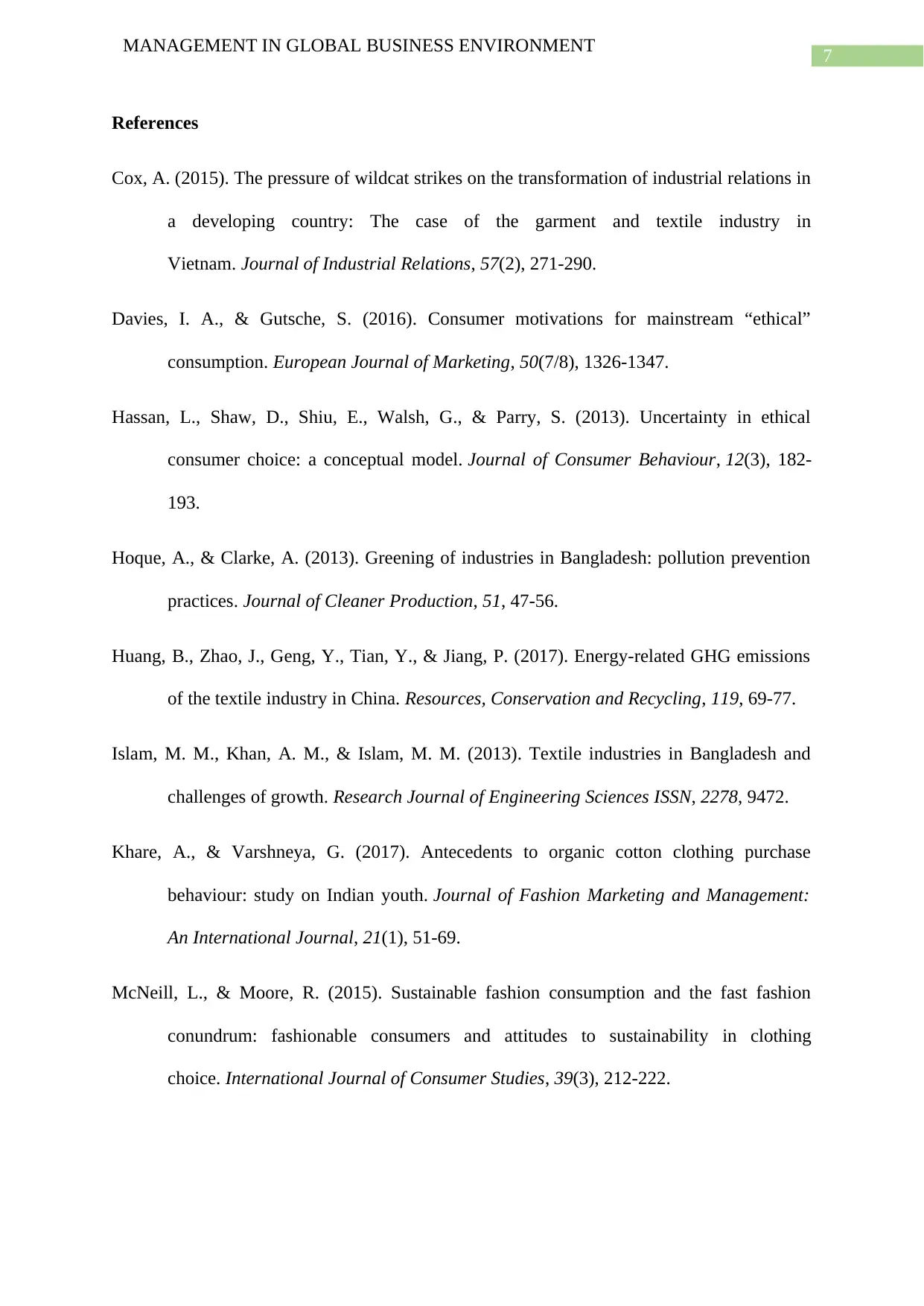
7
MANAGEMENT IN GLOBAL BUSINESS ENVIRONMENT
References
Cox, A. (2015). The pressure of wildcat strikes on the transformation of industrial relations in
a developing country: The case of the garment and textile industry in
Vietnam. Journal of Industrial Relations, 57(2), 271-290.
Davies, I. A., & Gutsche, S. (2016). Consumer motivations for mainstream “ethical”
consumption. European Journal of Marketing, 50(7/8), 1326-1347.
Hassan, L., Shaw, D., Shiu, E., Walsh, G., & Parry, S. (2013). Uncertainty in ethical
consumer choice: a conceptual model. Journal of Consumer Behaviour, 12(3), 182-
193.
Hoque, A., & Clarke, A. (2013). Greening of industries in Bangladesh: pollution prevention
practices. Journal of Cleaner Production, 51, 47-56.
Huang, B., Zhao, J., Geng, Y., Tian, Y., & Jiang, P. (2017). Energy-related GHG emissions
of the textile industry in China. Resources, Conservation and Recycling, 119, 69-77.
Islam, M. M., Khan, A. M., & Islam, M. M. (2013). Textile industries in Bangladesh and
challenges of growth. Research Journal of Engineering Sciences ISSN, 2278, 9472.
Khare, A., & Varshneya, G. (2017). Antecedents to organic cotton clothing purchase
behaviour: study on Indian youth. Journal of Fashion Marketing and Management:
An International Journal, 21(1), 51-69.
McNeill, L., & Moore, R. (2015). Sustainable fashion consumption and the fast fashion
conundrum: fashionable consumers and attitudes to sustainability in clothing
choice. International Journal of Consumer Studies, 39(3), 212-222.
MANAGEMENT IN GLOBAL BUSINESS ENVIRONMENT
References
Cox, A. (2015). The pressure of wildcat strikes on the transformation of industrial relations in
a developing country: The case of the garment and textile industry in
Vietnam. Journal of Industrial Relations, 57(2), 271-290.
Davies, I. A., & Gutsche, S. (2016). Consumer motivations for mainstream “ethical”
consumption. European Journal of Marketing, 50(7/8), 1326-1347.
Hassan, L., Shaw, D., Shiu, E., Walsh, G., & Parry, S. (2013). Uncertainty in ethical
consumer choice: a conceptual model. Journal of Consumer Behaviour, 12(3), 182-
193.
Hoque, A., & Clarke, A. (2013). Greening of industries in Bangladesh: pollution prevention
practices. Journal of Cleaner Production, 51, 47-56.
Huang, B., Zhao, J., Geng, Y., Tian, Y., & Jiang, P. (2017). Energy-related GHG emissions
of the textile industry in China. Resources, Conservation and Recycling, 119, 69-77.
Islam, M. M., Khan, A. M., & Islam, M. M. (2013). Textile industries in Bangladesh and
challenges of growth. Research Journal of Engineering Sciences ISSN, 2278, 9472.
Khare, A., & Varshneya, G. (2017). Antecedents to organic cotton clothing purchase
behaviour: study on Indian youth. Journal of Fashion Marketing and Management:
An International Journal, 21(1), 51-69.
McNeill, L., & Moore, R. (2015). Sustainable fashion consumption and the fast fashion
conundrum: fashionable consumers and attitudes to sustainability in clothing
choice. International Journal of Consumer Studies, 39(3), 212-222.
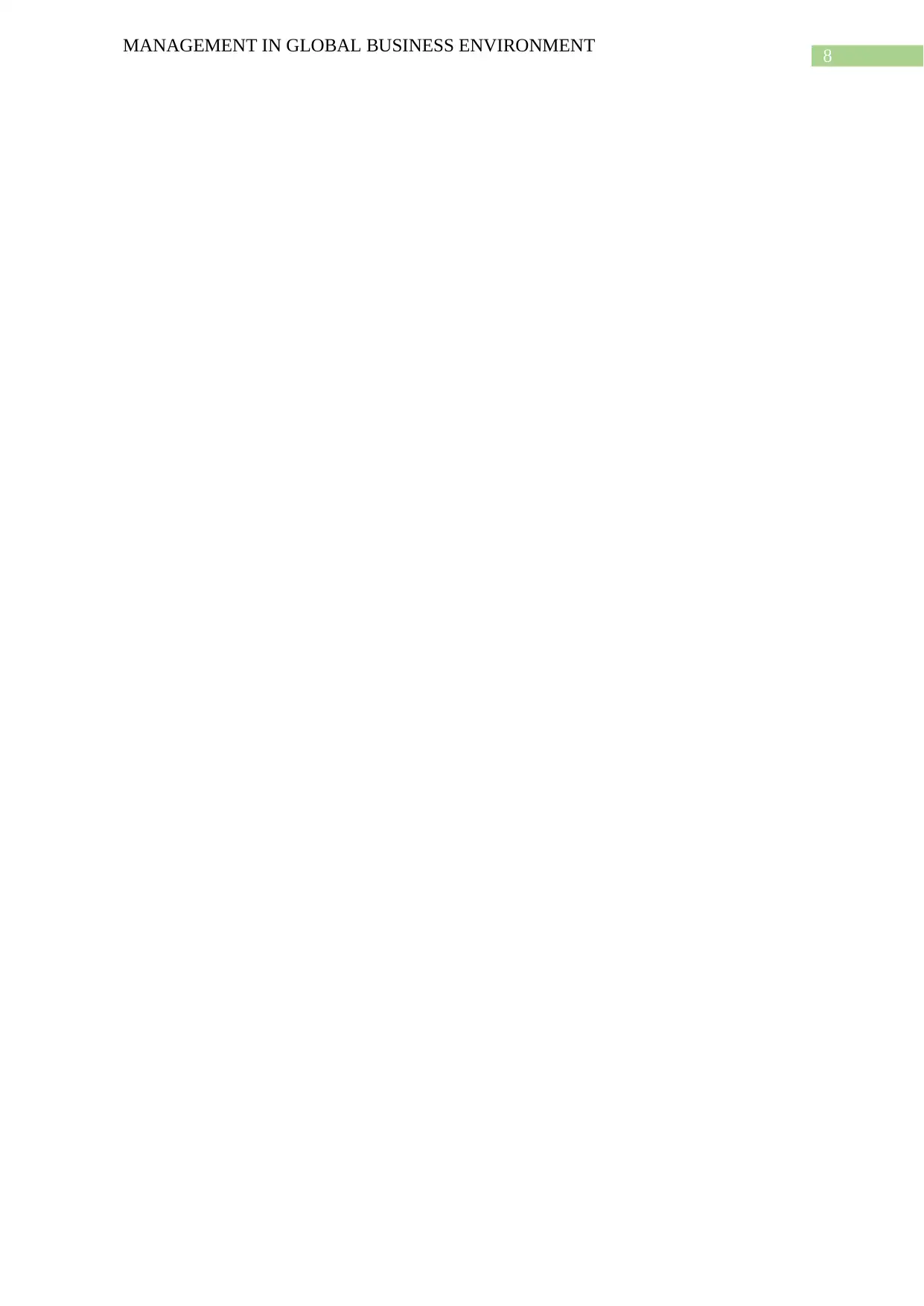
8
MANAGEMENT IN GLOBAL BUSINESS ENVIRONMENT
MANAGEMENT IN GLOBAL BUSINESS ENVIRONMENT
⊘ This is a preview!⊘
Do you want full access?
Subscribe today to unlock all pages.

Trusted by 1+ million students worldwide
1 out of 9
Related Documents
Your All-in-One AI-Powered Toolkit for Academic Success.
+13062052269
info@desklib.com
Available 24*7 on WhatsApp / Email
![[object Object]](/_next/static/media/star-bottom.7253800d.svg)
Unlock your academic potential
Copyright © 2020–2025 A2Z Services. All Rights Reserved. Developed and managed by ZUCOL.





